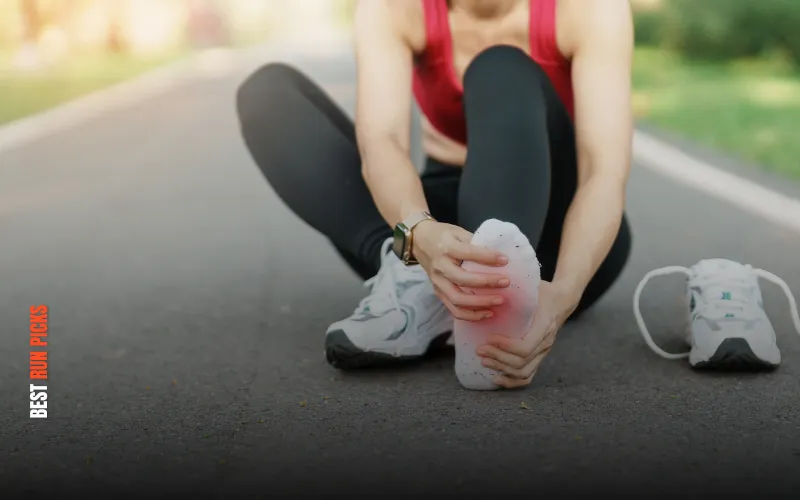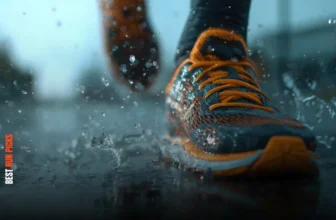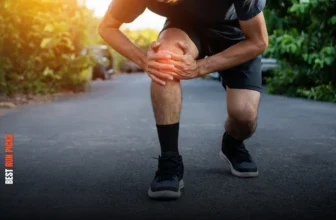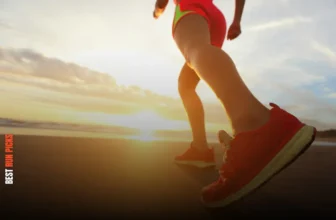
If you’re just starting your running journey and dealing with heel pain, you’re not alone. Studies suggest that 1 in 10 people will experience plantar fasciitis at some point in their lives, and beginner runners are particularly at risk because their feet aren’t yet conditioned for the repeated stress of running. Choosing the best running shoes for beginners plantar fasciitis isn’t just about comfort—it’s about preventing injury, reducing downtime, and making running an enjoyable habit you’ll actually stick with.
Imagine this: You lace up, step outside, and every stride feels cushioned and supported instead of sharp and painful. That’s the difference the right shoes make. For people with plantar fasciitis, the wrong pair of shoes can mean months of heel pain, lost training progress, and even medical bills for physical therapy. But the right pair? It can help you run farther, recover faster, and actually enjoy the sport without constant fear of aggravating your condition.
In this 2025 pain-relief guide, we’ll break down the science of plantar fasciitis, explain the features to look for in supportive shoes, and review the top 5 running shoes for plantar fasciitis beginners. Whether you’re preparing for your first 5K or simply want to run without pain, this guide has you covered.
Top Picks At a Glance
In a hurry? Here are the 5 Best Running Shoes for Beginners Plantar Fasciitis:
- Brooks Ghost 16: Men / Women
- Asics Gel-Kayano 31: Men / Women
- New Balance 1080v14: Men / Women
- Hoka Clifton 9: Men / Women
- Saucony Triumph 22: Men / Women
Understanding Plantar Fasciitis
Before diving into shoe recommendations, it’s important to understand what plantar fasciitis is and why it’s so common among new runners.
What Is Plantar Fasciitis?
Plantar fasciitis is the inflammation of the plantar fascia, a thick band of tissue connecting your heel bone to your toes. It acts like a shock absorber, supporting the arch of your foot with every step. Overuse, poor footwear, or sudden increases in activity can strain this tissue, causing microtears that lead to inflammation and pain.
The hallmark symptom? Sharp heel pain in the morning or after long periods of rest. For runners, the pain often worsens after activity rather than during it.
Why Beginners Are More at Risk
New runners are especially prone to plantar fasciitis because:
- Their feet and arches aren’t yet adapted to repetitive impact.
- Many start training too aggressively, logging high mileage too soon.
- Beginners often wear generic sneakers without the right support or cushioning.
A 2022 American Academy of Orthopaedic Surgeons report found that over 25% of beginner runners experience foot injuries within their first year, with plantar fasciitis ranking among the most common.
Expert Insight
Dr. Emily Splichal, a podiatrist and human movement specialist, explains:
Real-Life Example
Take James, a 32-year-old office worker who decided to train for his first 10K. He bought inexpensive running shoes without considering heel support. Within six weeks, he developed intense heel pain that sidelined him for months. After switching to plantar fasciitis pain relief shoes designed with cushioning and arch stability, James gradually returned to running pain-free.
What to Look for in Running Shoes for Plantar Fasciitis
Choosing the right running shoes for plantar fasciitis beginners requires more than grabbing the most popular pair on the shelf. Certain design features are essential to reduce strain on your heel and arch.
Cushioning and Shock Absorption
Running generates high-impact forces, especially on hard surfaces like concrete or asphalt. Shoes with advanced midsole cushioning—such as EVA foam or proprietary technologies like Nike ZoomX or Brooks DNA Loft—help absorb shock and reduce stress on the plantar fascia.
Arch Support and Stability
Flat or unsupportive shoes can cause overpronation, where the foot rolls inward excessively. Over time, this increases tension on the plantar fascia. Look for shoes with structured arch support or stability features that promote a natural gait cycle.
Heel Support and Pain Relief Features
Because plantar fasciitis pain is concentrated in the heel, a firm heel counter and deep heel cup are critical. These stabilize your heel, distribute pressure more evenly, and prevent the painful microtears that come with instability.
Lightweight Design for Beginners
Beginners often fatigue faster, and heavy shoes only add strain. A lightweight yet supportive design helps maintain good form while reducing unnecessary stress on the feet.
Breathability and Long-Distance Comfort
Sweaty, overheated feet can make running miserable. Mesh uppers with moisture-wicking liners ensure your feet stay cool, dry, and blister-free—even on longer runs.
Comparison Table: Key Features in Plantar Fasciitis Running Shoes
| Feature | Why It Matters | Best For |
|---|---|---|
| Cushioning | Reduces impact on the heel and fascia | Beginners on hard surfaces |
| Arch Support | Prevents overpronation and strain | Runners with flat feet or high arches |
| Heel Stability | Distributes pressure, prevents pain | Plantar fasciitis sufferers |
| Lightweight Build | Reduces fatigue, promotes proper form | New runners, long-distance beginners |
| Breathable Uppers | Keeps feet dry, prevents blisters | All climates, sweaty runners |
By focusing on these elements, you’ll be able to select supportive running shoes 2025 models that balance comfort, performance, and pain relief.
The 5 Best Running Shoes for Beginners Plantar Fasciitis (2025 Picks)
With so many models on the market, it can feel overwhelming to choose the right pair. To make things easier, we’ve narrowed it down to the five best running shoes for beginners plantar fasciitis in 2025, each carefully selected for comfort, support, and pain relief.
1. Brooks Ghost 16
If you want a shoe that delivers consistent comfort and proven results, the Brooks Ghost 16 tops our list.
Key Features:
- DNA Loft v3 cushioning for soft yet responsive rides
- Segmented crash pad to reduce heel strike impact
- 3D Fit Print upper for lightweight structure
- Deep heel cup for stable landings
Why It’s Great for Plantar Fasciitis Beginners:
The Ghost 16 offers the ideal balance of cushioning and structure, making it one of the best plantar fasciitis pain relief shoes for new runners. Its plush midsole absorbs shock while the supportive heel counter minimizes irritation at the fascia insertion point.
- Excellent heel support
- Versatile for walking and running
- Wide range of sizes and widths
- Runs slightly narrow for wide-footed runners
- Higher price point compared to entry-level shoes
User Insight:
Many reviewers on Runner’s World mention reduced heel pain within weeks of switching to the Ghost series, making it a safe bet for beginners starting their running journey.
2. Asics Gel-Kayano 31
For beginners who overpronate (feet roll inward), the Asics Gel-Kayano 31 is a lifesaver.
Key Features:
- Dynamic DuoMax stability system
- Gel cushioning in both heel and forefoot
- FF Blast+ midsole for energy return
- Engineered mesh upper with eco-friendly materials
Why It’s Great for Plantar Fasciitis Beginners:
Overpronation is a leading cause of plantar fascia strain. The Kayano 31 provides firm arch support and stability without sacrificing cushioning. It’s one of the most supportive running shoes 2025 has to offer for runners who need both guidance and comfort.
- Reliable for runners with flat feet
- Great for long-distance training
- Durable outsole suitable for multiple surfaces
- Heavier than neutral shoes
- Expensive for beginners on a budget
User Insight:
A podiatry clinic survey ranked the Kayano series as one of the most recommended shoes for plantar fasciitis beginners in 2024, with strong endorsements for its corrective stability.
3. New Balance 1080v14
If heel pain is your main concern, the New Balance 1080v14 should be high on your list.
Key Features:
- Fresh Foam X cushioning for maximum softness
- Rocker design to reduce heel strike pressure
- Bootie construction for snug fit
- Ortholite sockliner for added comfort
Why It’s Great for Plantar Fasciitis Beginners:
The Fresh Foam midsole provides exceptional shock absorption, making it one of the top cushioned shoes for heel pain in 2025. The rocker sole reduces tension on the plantar fascia during toe-off, giving beginners a smoother, less painful stride.
- Extremely plush underfoot feel
- Wide-toe box suitable for different foot shapes
- Smooth transitions for easy runs
- May feel too soft for runners who prefer firm shoes
- Slightly bulky for speed workouts
User Insight:
Runners with chronic heel pain often report that the 1080 series allows them to log miles without flare-ups. One reviewer called it “a pain-relief pillow for the road.”
4. Hoka Clifton 9
For beginners who want a shoe that feels featherlight but still protects their feet, the Hoka Clifton 9 is a top contender.
Key Features:
- Early-stage Meta-Rocker geometry for smooth transitions
- CMEVA midsole foam for balanced cushioning
- Lightweight engineered mesh upper
- Moderate heel bevel for stability
Why It’s Great for Plantar Fasciitis Beginners:
Hoka is known for its max-cushioning philosophy, and the Clifton 9 delivers on that promise without feeling clunky. Its rocker sole helps roll you forward, reducing direct heel pressure—a huge win for anyone dealing with plantar fasciitis.
- Ultra-lightweight for long runs
- Excellent shock absorption
- Stylish design works as casual wear too
- Lower durability compared to heavier models
- Midsole may compress faster for heavy runners
User Insight:
Beginner runners transitioning from walking to jogging found the Clifton 9 especially forgiving, often describing it as “gliding” instead of pounding.
5. Saucony Triumph 22
If budget isn’t a major concern and you want a plush, high-performance shoe, the Saucony Triumph 22 is worth the investment.
Key Features:
- PWRRUN+ foam for maximum cushioning
- FormFit upper adapts to foot shape
- Durable outsole for road mileage
- Deep heel cradle for stability
Why It’s Great for Plantar Fasciitis Beginners:
The Triumph 22 is engineered for luxury. Its deep heel cradle and responsive foam make it one of the most effective plantar fasciitis pain relief shoes in the premium category. Beginners who want the softest landings and longest lifespan will appreciate this model.
- Plush cushioning ideal for long runs
- Adaptable fit for different foot shapes
- Long-lasting outsole durability
- Premium pricing
- May feel too heavy for short runs or sprints
User Insight:
Many runners describe the Triumph series as “running on clouds.” For plantar fasciitis beginners, the shoe delivers a combination of shock absorption and stability that justifies its higher price.
Quick Comparison Table
| Shoe Model | Best For | Key Benefit | Weight |
|---|---|---|---|
| Brooks Ghost 16 | Overall pick | Balance of cushioning + stability | ~10 oz |
| Asics Gel-Kayano 31 | Overpronators | Arch support + stability | ~11 oz |
| New Balance 1080v14 | Heel pain | Plush cushioning + rocker sole | ~10.3 oz |
| Hoka Clifton 9 | Lightweight | Rocker design, low heel pressure | ~8.7 oz |
| Saucony Triumph 22 | Premium comfort | Maximum cushioning + durability | ~10.5 oz |
Tips for New Runners with Plantar Fasciitis
Even with the best running shoes for beginners plantar fasciitis, footwear alone isn’t the complete solution. Combining the right shoes with smart habits will help you recover faster, prevent reinjury, and enjoy running for years to come.
1. Start Slow and Progress Gradually
One of the most common mistakes beginners make is increasing mileage too quickly. Follow the 10% rule: don’t increase your weekly mileage by more than 10%. This gives your plantar fascia time to adapt to stress.
2. Stretch and Strengthen Regularly
Tight calves and weak foot muscles contribute to plantar fasciitis. Add these routines to your schedule:
- Calf stretches: Hold for 30 seconds, repeat 3 times per leg.
- Towel stretch: Sit, loop a towel around your toes, and gently pull.
- Toe curls with a towel: Strengthens arch-supporting muscles.
3. Use Orthotic Inserts if Needed
Custom or over-the-counter orthotics can add extra arch support. They pair especially well with cushioned shoes for heel pain if you need additional stability.
4. Run on Softer Surfaces
Whenever possible, choose tracks, treadmills, or trails over concrete. Softer surfaces reduce the impact on your heel and fascia.
5. Listen to Your Body
If your pain worsens despite good shoes and stretching, consult a podiatrist. Sometimes additional treatment such as physical therapy, night splints, or corticosteroid injections may be needed.
Conclusion: Take the First Step Toward Pain-Free Running
Plantar fasciitis can be discouraging, but it doesn’t have to end your running journey before it begins. The right footwear—combined with smart training habits—makes all the difference.
Each model is engineered to support your arch, cushion your heel, and reduce fascia strain, helping you enjoy running instead of dreading the pain.
Ready to take the first step? Invest in a pair of supportive running shoes 2025 designed for plantar fasciitis beginners. Your feet—and your future running self—will thank you.
Call to Action:
👉 Explore the models we reviewed, try them on if possible, and choose the pair that feels most natural for your stride. Start slow, listen to your body, and let your new shoes carry you toward a pain-free running journey.
Frequently Asked Questions (FAQ)
1. How do I know if I need special running shoes for plantar fasciitis?
If you feel stabbing heel pain when you wake up or after a run, that’s a major sign. Shoes designed for plantar fasciitis have better cushioning, arch support, and heel stability than standard running shoes.
2. Can I run in regular sneakers if I have plantar fasciitis?
Technically yes, but it’s not recommended. Regular sneakers usually lack the structured support and cushioning needed for plantar fasciitis pain relief shoes. Over time, this can make your condition worse.
3. Are supportive running shoes 2025 models really better than older versions?
Yes. Shoe companies continuously update their midsoles, uppers, and support systems. The 2025 models we reviewed integrate new foams and heel designs that significantly improve shock absorption and stability.
4. Should I wear my plantar fasciitis running shoes all day?
For beginners still dealing with pain, wearing your running shoes during the day can help minimize discomfort. However, you should rotate between supportive shoes to avoid over-compressing the midsole.
5. How long will it take to run pain-free with the right shoes?
Results vary. Some beginners notice improvement within weeks, while others take months. Proper stretching, gradual training, and choosing the best running shoes for beginners plantar fasciitis will speed up recovery.















